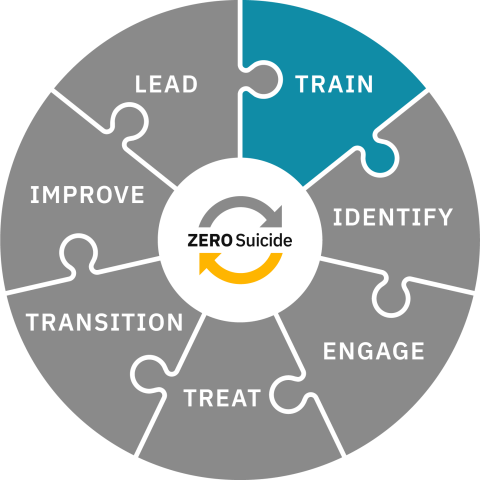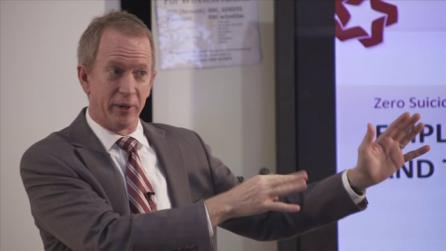
Train
Train a competent, confident, and caring workforce.
Toolkit
Train
Training for All
When an organization makes a commitment to Zero Suicide, everyone understands that safe suicide care begins the moment the patient walks through the door for the first time. It is essential that all staff members have the necessary skills to provide excellent care, which in turn will help staff to feel more confident in their ability to provide caring and effective assistance to patients with suicide risk.
In a Zero Suicide approach:
- Employees are assessed for the beliefs, training, and skills needed to care for individuals at risk of suicide.
- All employees, clinical and non-clinical, receive suicide prevention training appropriate to their role.
Question
How will we formally assess staff on their perception of their confidence, skills, and perceived support to care for individuals at risk for suicide? What training will we then provide for staff to develop the needed skills?
To Implement Zero Suicide
Assess Staff Skills
- Conduct an assessment of staff knowledge, practices, and confidence in providing safer suicide care.
- Repeat the assessment at least every three years.
The Zero Suicide Workforce Survey is the ideal tool for assessing staff knowledge, practices, and confidence. See the Zero Suicide Workforce Survey tab above for detailed information.
Train Staff in Key Skills
- Provide staff training commensurate with their roles in providing safer suicide care.
- Repeat training at least every three years.
- Ensure that training contains the following elements:
- The fundamentals of the organization’s Zero Suicide philosophy
- Policies and protocols relevant to the staff member’s role and responsibilities
- Basic, research-informed training on suicide identification for all staff
- Additional training to all clinical staff to ensure a basic level of skill in assessing, managing, and treatment planning for patients at risk of suicide, including safety planning and reduction of access to lethal means
- Advanced training to deepen skills and increase confidence and effectiveness
Available Trainings
Many training workshops are available and choosing the right one for your organization’s needs may seem challenging.
Go to the Training Workshops tab above for information about training programs and an activity demonstrating how an organization might go about choosing the right training for specific categories of staff. See Suicide Care Training Options for a chart summarizing the most widely used programs and their audiences and length.
Workforce Survey
Overview of the Zero Suicide Workforce Survey
One component of a Zero Suicide framework is a competent, confident, and well-trained workforce, regardless of role or responsibility. The Zero Suicide Workforce Survey is one tool your organization can use to assess staff self-perception of their knowledge and comfort interacting with patients who may be at risk for suicide, including comfort and skill providing specific elements of care such as screening, treatment, and support during care transitions.
This survey can serve multiple functions:
- Provide for leadership a snapshot of how prepared staff actually feel about providing suicide care and will also likely reinforce that change is needed and welcome
- Provide an opportunity to let staff know that their input throughout the launch and implementation of your system-wide suicide care initiative will be welcome and desired
- Assist your implementation team in designing and prioritizing training needs
Using the Survey Results
Survey results should inform leadership about how prepared staff feel to provide suicide care, assist in the development of training plans in your organization, and help establish a baseline for your implementation approach.
The following quote from the Zero Suicide Breakthrough Series: Outcomes and Recommendations report illustrates what you can learn by administering the Workforce Survey:
The workforce survey came as a surprise to many providers in terms of how unsure their staff were in handling people with symptoms of suicide short of hospitalization. The data created an opportunity for increased buy-in among staff for additional training.1
See the Guidelines for Administering the Workforce Survey resource for additional information about analyzing and sharing results.
Findings from Other Organizations
The general findings from more than 35,000 responses to an earlier version of the Zero Suicide Workforce Survey across nine states showed that a large number of staff at all levels do not have specific training in suicide care. Most organizations are likely to see similar results since clinicians get so little suicide-specific training in graduate school.
- Between 35% and 45% don’t feel they have the skills
- Between 40% and 50% don’t feel they have the training
- Between 30% and 40% don’t feel they have the support2
Suggestions for Using Results
Zero Suicide Implementation Teams can use survey results to motivate staff commitment to the Zero Suicide goal and to guide the selection of training workshops to build staff skills in areas the survey shows to be weakest.
For example, one organization that administered the survey at the launch of their Zero Suicide initiative and repeated administration of the Work Force Survey a year later found dramatic changes in staff responses:
- Number of all staff responding that they had the training, skills, and support increased by more than half, from just 36% on the first survey to 86% on the second
- Number responding that they did not have the training, skills, and support decreased from 27% to 2%
Administering the Workforce Survey
The Zero Suicide Workforce Survey takes an average of 10–15 minutes to complete, and the responses are anonymous. It contains branching logic to match certain categories of survey questions with relevant staff based on their role in the organization.
Organizations can either request access to the online version of the Workforce Survey or use the PDF document with the survey questions to create their own online survey or administer the survey on paper.
We recommend the survey be re-administered at least once every three years, either among a specific group of staff members or the entire staff, to re-assess knowledge, comfort, and skills.
"St. Luke's Behavioral Health outpatient clinic provided the Workforce Survey to their staff members on paper and allotted time during a staff meeting for its completion. Leadership had already communicated with staff about initiating the Zero Suicide initiative, explaining their intent to gauge staff members' thoughts and perceptions about the suicide care they provided to patients. After achieving an impressive response rate of 90%, they convened focus groups with staff to share the survey results and delve deeper into understanding staff needs. Through this transparent process, they exemplified a Just Culture, increased trust between staff and the organization, and were able to develop plans to enhance staff support and training."
Accessing the Workforce Survey
To request access to the online Workforce Survey please click the following link: Workforce Survey Request Form.
The Zero Suicide Workforce Survey Resources page contains the additional resources listed below:
- PDF document with the survey questions
- Guidelines for Administering the Workforce Survey
- Sample letter to staff about the survey
- Sample survey results report
- 1National Council for Behavioral Health. (2015). Zero suicide breakthrough series: Outcomes and recommendations. Retrieved from https://zerosuicide.edc.org/resources/resource-database/breakthrough-se…
- 2Silva, C., Smith, A. R., Dodd, D. R., Covington, D. W., & Joiner, T. E. (2016). Suicide-related knowledge and confidence among behavioral health care staff in seven states. Psychiatric Services, 67(11), 1240–1245. Retrieved from http://ps.psychiatryonline.org/doi/pdf/10.1176/appi.ps.201500271
Training Workshops
For Clinicians and Staff
Clinicians and staff members must be confident in their ability to create a helping alliance with a person contemplating suicide. Confidence can arise from various sources:
- An understanding that suicide is preventable
- Clear policies and management plans to engage with patients and clients who are thinking about suicide
- A staff member’s skill in asking “Are you thinking about taking your life?”
The following provides a brief overview of training suggested for various staff roles and responsibilities:
- Non-clinical staff
- All professionals who screen incoming patients
- Behavioral health clinicians
- Primary care staff and clinicians
The resource Suicide Care Training Options describes the most widely used training workshops for the health and behavioral health care workforce.
Non-Clinical Staff
All non-clinical staff, including receptionists, administrative staff, and technicians, should be trained to identify patients who are at risk for suicide. People who are experiencing suicidal thoughts often disclose them to non-clinical staff, so all staff members should be on alert for someone who might be at risk from the moment the person first calls for an appointment or walks in the door.
The trainings that would be appropriate for non-clinical staff are generally called gatekeeper training.
Gatekeeper training provides an overview of suicide prevention. Participants learn how to recognize suicidal behavior, how to respond, and where to make a referral and find help. It does not teach how to do a clinical assessment of a person at risk for suicide.
All professional staff members who will be asked to screen new patients at intake must be trained in how to conduct a screening, preferably using a tool that is informed by evidence of its ability to accurately identify those at risk. Those staff members may include paraprofessionals, nurses, nurse practitioners, and physician assistants in primary care settings or emergency department staff. In integrated or primarily behavioral health organizations, intake workers, case managers, or other professionals may be included in this category.
Note: Available screening tools are described in the Identify section. Not all developers of screening tools offer training.
Primary Care
Primary care staff, including physicians, nurses, nurse practitioners, physician assistants, paraprofessionals, and administrative staff should receive training in recognizing risk factors and warning signs. Primary care practices should develop policies and protocols for referring and managing patients at risk for suicide.
SPRC’s primary care toolkit is another useful resource for guidance in developing primary care policies and practices.
Behavioral Health
Behavioral health clinicians working with patients or clients who may be at risk for suicide include social workers, psychologists, professional counselors, marriage and family therapists, psychiatric nurses, and psychiatrists. Training for this group should teach these essential skills:
- An approach that acknowledges the ambivalence of the person considering suicide and affirms that alternatives to alleviating the patient’s pain do exist.
- The ability to gather patient information beyond suicide screening information that will inform a risk formulation.
- The ability to form and communicate to other clinicians, supervisors, and the patient a contextualized risk formulation to aid safety planning, counseling to reduce access to lethal means, crisis support, and treatment planning.
- The ability to write a clear risk formulation for the patient record.
- A commitment to collaborating with the patient and others who are significant in the patient’s life to create and record a safety plan and crisis support plan.
- Knowledge of the available treatment options and the ability to consider those options that are least restrictive to the patient whenever possible.
Next Steps
Assess and Train Clinical and Non-Clinical Staff
The basic next step to assess and train clinical and non-clinical staff is:
- Administer the Zero Suicide Work Force Survey to all clinical and non-clinical staff to learn more about staff’s perceptions of their comfort and competence caring for those at risk for suicide.
Planning Next Steps
There are several additional items to help you plan these next actions:
Getting Started with Zero Suicide
This one-page tool lists ten actions to take to start implementing Zero Suicide. Use this tool to get started on the path you will take to adopt this comprehensive suicide care approach.
Getting Further with Zero Suicide
This tool lists several actions you can take if you have been implementing Zero Suicide for a while and are not sure what to do next or need help taking your Zero Suicide work a little further.
Zero Suicide Organizational Self-Study
Every organization should complete the self-study as one of the first steps in adopting a Zero Suicide approach. While the self-study is available in the Lead section of the Zero Suicide online toolkit, it’s provided again here for your convenience.
Zero Suicide Work Plan Template
This form contains an expanded list of action steps to guide your implementation team in creating a full work plan to improve care and service delivery in each of the seven core Zero Suicide components.



